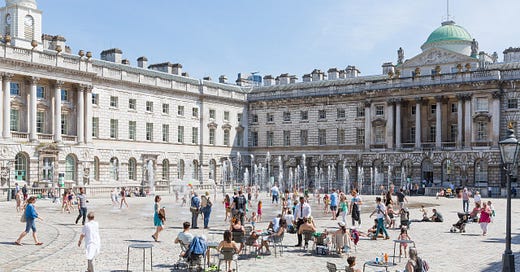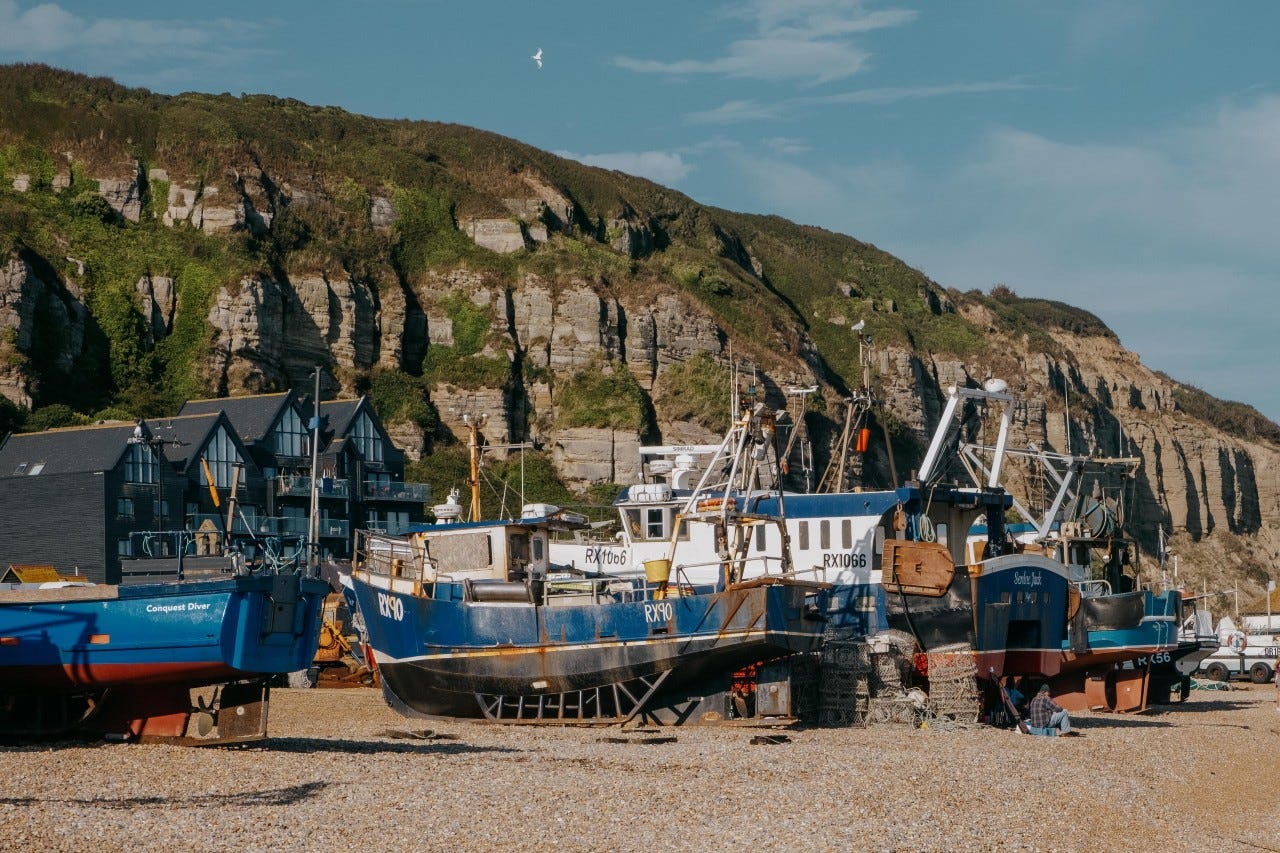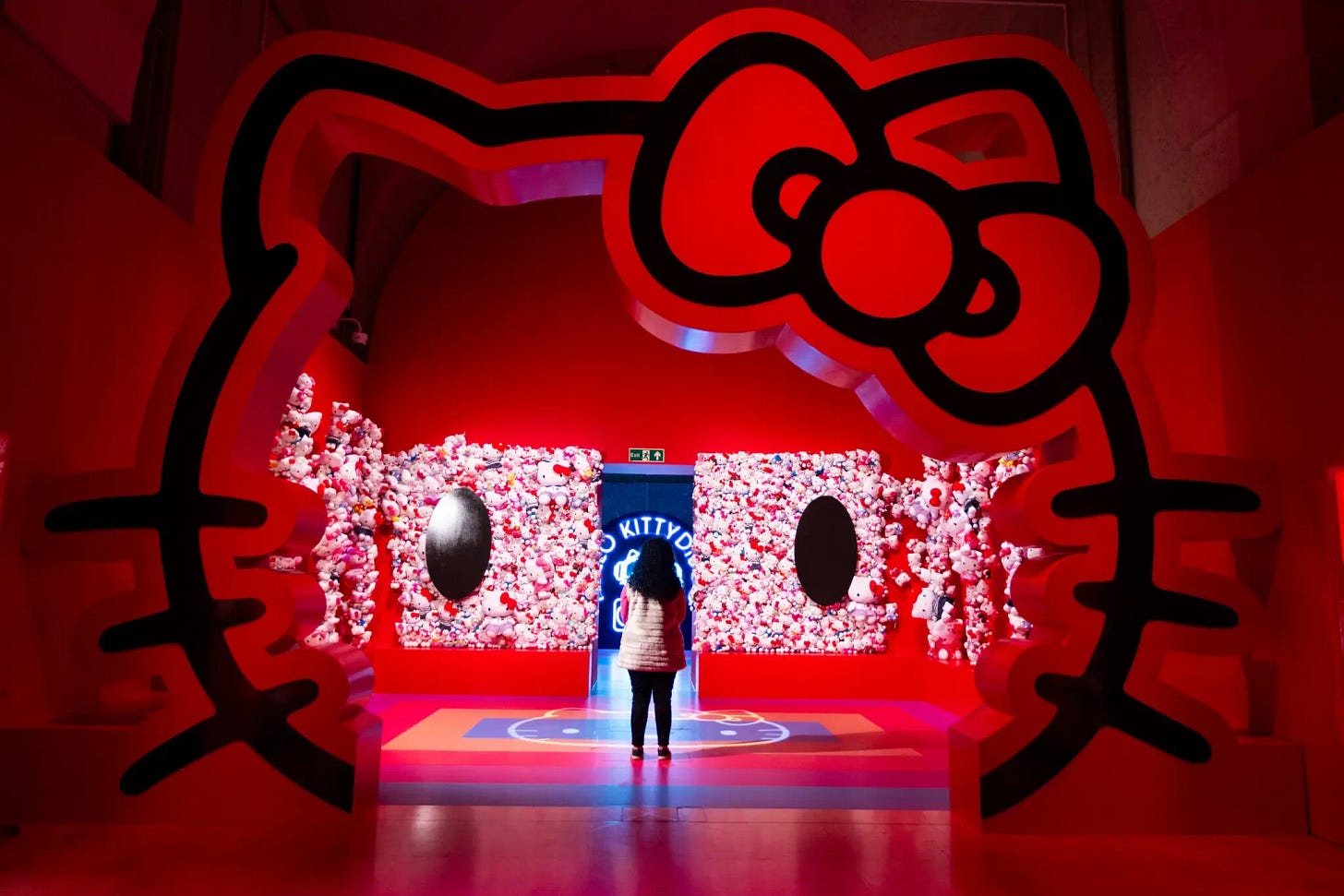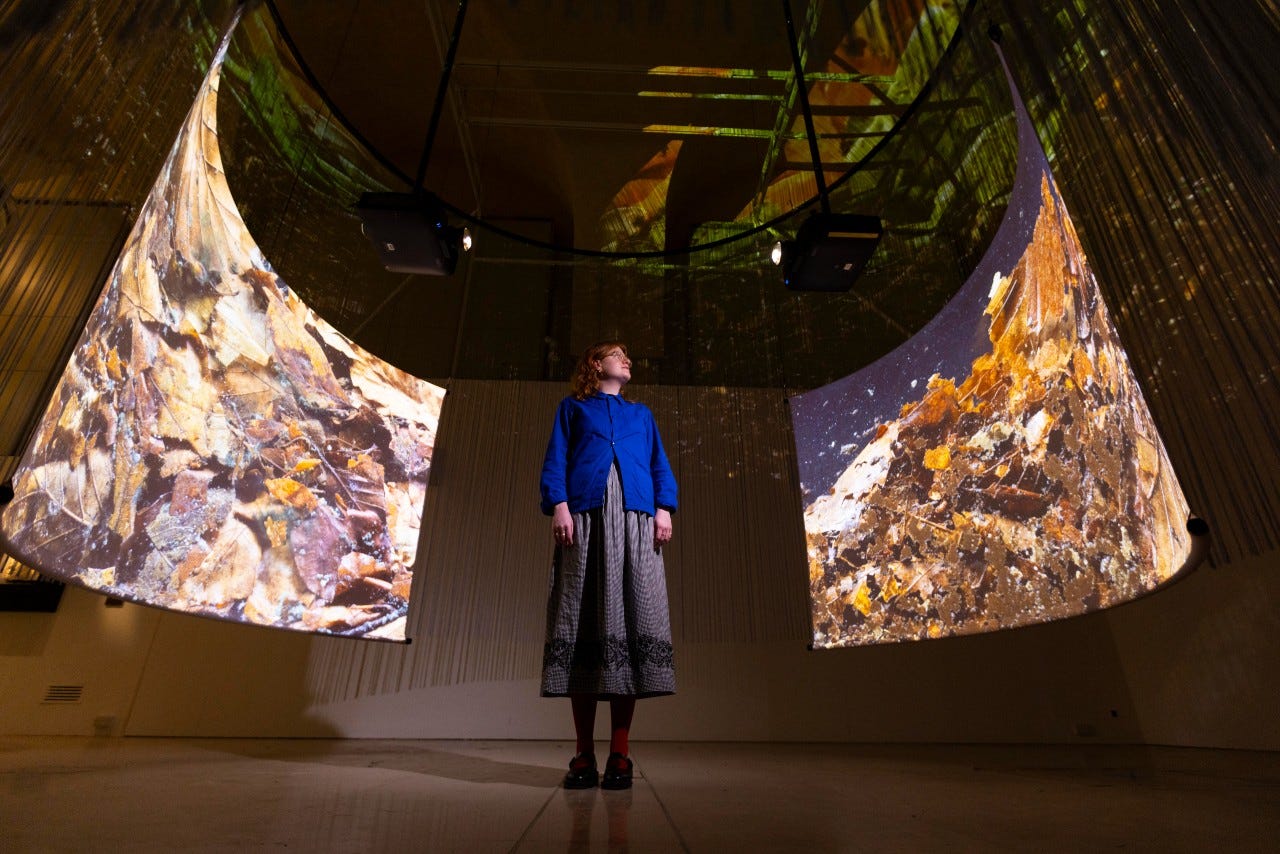No taxpayer cash: 25 years of Somerset House
INTERVIEW: Director Jonathan Reekie on Somerset House's milestone birthday
Thursday 20 March 2025 | views from the world of museums, galleries, heritage and art
Hello. I’m back with another mid-week/feature-packed edition of this newsletter!
My Big Interview is with the Director of Somerset House Jonathan Reekie as the arts venue celebrates its 25th birthday 🎂
In the 250 Take guest column, Kathleen Soriano explains why Hastings Contemporary is stepping up to protect one of the coastal town’s most important communities 🌊
And in the Hot List, Victor Hugo’s drawings cross the channel for the first time in 50 years 🇫🇷
Let’s dive into it!
— maxwell
The Hot List
My curated round-up of what’s new to see, do, watch, read and more.
*I may earn a small commission from purchases made through some links below
EXHIBITION
1️⃣ Astonishing Things: The Drawings of Victor Hugo | at the Royal Academy, London
The little-known drawings of the great Les Misérables writer get a rare public showing — and their first in Britain in half-a-century. “Weird and psychedelic” is the Telegraph’s verdict.
opens Friday | find out more
BOOK
2️⃣ Hidden Portraits: The Untold Stories of Six Women Who Loved Picasso | by Sue Roe
The stories of six extraordinary women who shared Pablo Picasso's life are revealed for the first time. Each were instrumental in his career, yet they have long been dismissed as simply passive models or muses — until now.
published on 27 March | pre-order your copy now
EXPERIENCE
3️⃣ Still The Hours | at Hampton Court Palace, London
The world-premiere of a brand-new, genre-defying after-dark walking experience around Henry VIII’s magnificent palace. Explore with a richly layered soundscape that brings women of the past to life and stars Miranda Richardson.
runs 19 to 30 March | book your ticket
TV
4️⃣ Ancient Greece by Train with Alice Roberts | on Channel 4
Professor Alice Roberts takes to the railways of Greece and Turkey to travel back thousands of years to learn about the Ancient Greek civilisation and its powerful effect on our lives today.
next episode Saturday 20:15 | stream episode 1 here
EXHIBITION
5️⃣ Louise Bourgeois: I Have Been to Hell and Back. And Let Me Tell You, It Was Wonderful | Fubon Art Museum, Taipei
Still reaching new destinations 15 years after her death, this is Bourgeois’ first major exhibition in Taiwan. 60 works, including the iconic monumental “Spider” sculptures, are now on show.
now open until 30 June | find out more
The 250 Take
An opinion column — in 250 words — by a guest writer.
💬 Hastings' fishing communities are at risk. Our town's gallery is stepping up
by Kathleen Soriano
“As a kid, playing with your next-door neighbours was the highlight of any day. Imagine therefore, as a grown up, being able to do the same ... but that those pals are fishermen with real-life boats and a wealth of salty stories?
We talk a great deal in the museum sector about the importance of place-making and our vital contribution to that, but we cannot be effective place-makers without connecting deeply with the communities that surround us.
At Hastings Contemporary — probably the only UK gallery that sits on the beach — our closest neighbour is the Hastings Fishermen’s Protection Society. Our new joint project and exhibition sees us working together to recognise their vital contribution to Hastings.
Home to one of Britain’s oldest and most historically significant fishing ports since Viking times, boats have launched from the beach that sits adjacent to Hastings Contemporary for over 1,000 years. Today it’s the oldest and largest beach-launched fishing fleet in Europe.
The boats parked up around us at the gallery are often more akin to a colourful sculpture park than a working industry. But such are the dramatic changes to coastline, sea temperature, the presence of fish, our project is even more crucial in preserving memory and meaning.
As our world changes, museums must find deeper connection with local meaning. At Hastings Contemporary, we too are considering the future impact of climate change, marine ecology and rising sea levels. A local concern maybe, but one that promises to have global impact.”
Kathleen Soriano is Interim Director of Hastings Contemporary. The Sun Feeds the Wind — supported by the National Lottery Heritage Fund — opens on 29 March and runs until 14 September 2025.
The Big Interview
Somerset House in the heart of London is 25 years old this year.
The actual building dates back further of course, but the grand and labyrinthine arts centre we know today first welcomed visitors in 2000. In fact, it’s one of my favourite little-known London facts that its elegant fountain-filled courtyard was a civil service car park for most of the 20th century — and the building had been home to tax inspectors for over 220 years.
But the new Millennium ushered in new tenants at the Georgian complex on the Thames. Since opening, it’s become home to the arts in the broadest possible terms — from hosting fashion exhibitions and sculptural installations, to film screenings, gigs, festivals and its annual skating ice rink. It welcomes millions of people each year.
At its core however — although admittedly little known to the wider public — is its role as a hub nurturing artists, creatives, and innovative small businesses. Hundreds of them call Somerset House home at any one time, using their dedicated offices, studios and co-working spaces to forge ahead in their careers — and hopefully fuel Britain’s creative future.
The most remarkable thing? Somerset House has done all this over a quarter-of-a-century without the UK taxpayer. Yes, it receives no regular state funding, and relies entirely on self-generated income — currently around £22m a year. And while I am an absolute advocate for the need for (more) public funding of our public art institutions, it does beg the question why can Somerset House make all their own cash while our bigger state-supported cultural institutions can’t make their sums add up?
So — being as this newsletter brings you the inside info — I thought I’d find out the answer. And I’ve gone straight to the top.
Today’s interview is with Jonathan Reekie, who has led Somerset House as Director for the past 11 years. (Which compared to his peers is a very long time.) He’s steered it through pandemics, recessions, and — as we get into — last year’s major fire.
In our wide-ranging chat here, we discuss the centre’s biggest money-spinners, the downsides to government funding, and the economics of a blockbuster exhibition. Oh, and I asked how you celebrate a quarter-of-a-century as one of London’s premier arts venues. TLDR: you open a cocktail bar!
***
Hello, and happy 25th birthday! What do you have planned in terms of celebrations?
Thank you! It’s so lovely to have a moment to reflect on where we’ve come from (a carpark and former government offices), to where we are now — a home of cultural innovators with over 2,000 creatives here.
For our birthday, we’ve put together a special year of programming, which includes commissions from many of our resident artists. It includes Hyzolic/Desires’ Salt Cosmologies commission in the courtyard, the Terrace Rooms and our Salt Stair, which has just opened, artist Tai Shani’s The Spell Or The Dream in the courtyard in August, and a very ambitious exhibition with Wayne McGregor at the end of the year.
We also have our Talent 25 initiative, supporting the next wave of creative talent, as an extension of our talent pathways into the creative sector. And of course, no birthday is complete without a party, so in September we will throw open the doors of the whole building with our Step Inside 25 weekend.
Our birthday year is about ensuring we have the right foundations in place for the next 25 years and so we’ve also launched a brand new visual identity and soon a new website, so we can let everyone know what goes on at Somerset House behind the façade and public programme.
Tell us how Somerset House is funded?
We’re proud at Somerset House to have a unique self-sustaining business model. We don’t receive any regular public funding, so have to rely on ourselves to generate the income needed to fulfil our mission as the home of cultural innovators and as a place that welcomes 3 million visitors annually.
We are responsible for the upkeep of the building, but it is also the source of our income. The largest proportion of income comes from renting space to creative enterprises. Of course, ticket revenue is very important — and our biggest ticket earner is Skate.
Another key revenue stream is commercial events income, which encompasses venue hire for private events for corporate clients, location filming and a small number of important third-party public events, including Photo London and 1-54 contemporary African art fair. And, as with many arts organisations, fundraising is an increasingly important part of the mix, especially in terms of enabling our talent pathways programmes for young people embarking on creative careers and supporting artists as part of Somerset House Studios.
In your most recent annual report, your Chair warns 2025's economic pressures will have a big effect. Would you prefer to receive a government subsidy to help counter economic volatility?
Wherever you fall in the funding mix, the sector has some shared challenges that aren’t determined by whether you receive regular government funding or not. The costs of running an organisation like Somerset House and putting on events and exhibitions have increased significantly, whilst our audiences, residents and staff all feel the impact of the cost of living crisis very directly. However, our model has always required us to flex according to the situation we find ourselves in.
Last year's CUTE exhibition was the most visited in your history. Was that a surprise, and what lessons have you taken from that?
Our programme is shaped around exploring important issues of our time from unexpected angles through a creative lens, across multiple disciplines. As a team we all felt instinctively positive about CUTE from the outset, as soon as our senior curator Claire Catterall first shared her ideas for the exhibition. Nonetheless, you can never predict how audiences will respond or how certain exhibitions will take off.
Of course, we were delighted that CUTE did just that, striking a chord with audiences right around the world and over 80% of people who came were first time visitors. It was a gift to have an exhibition that was so shareable and relatable online, where interest and engagement really gathered momentum. But I’m sure much of its success lay in the depth of ideas that were explored in the show, which explored cuteness in such a surprising, nuanced and multifaceted way.
If you’re asking whether there’s a magic formula that can be repeated with similar effect, I would say definitely not, but audiences are increasingly recognising that Somerset House’s unique brand of culture-making is exciting and relevant, and CUTE was a great example of this.
CUTE surely generated significant income for the organisation?
The financial upside of CUTE couldn’t have come at a better time as we are spending more than ever before on our cultural programme in 2025 for our 25th birthday year, and how we communicate that to audiences.
CUTE opens at the Kunsthal in Rotterdam this summer, which is fantastic. This is a new departure for us, so it’s a great first in our 25th birthday year. We don’t have a touring team at Somerset House and I’m sure your readers will appreciate the difference between international interest from other cultural organisations and the level of work involved in actually delivering an exhibition elsewhere, especially when the exhibition involves artworks and loans from so many different places. Touring CUTE is certainly not a very profitable endeavour, but it brings different benefits and is a fantastic way of extending the exhibition’s reach whilst hopefully building Somerset House’s reputation internationally.
And commercially, tell us why the annual SKATE ring is so important to Somerset House?
SKATE has become one of London’s best loved festive traditions and over the years it has also become a very important income stream for Somerset House. It is a real enabler for much of our programme the rest of the year, enabling us to take on much riskier projects and ensuring that we always have a free exhibition or installation available for the public to enjoy.
Over 160,000 people bought tickets to SKATE last year, whilst over 600,000 people came through Somerset House’s courtyard over the period to enjoy the atmosphere. You can enjoy watching other people skate and the ambience and food offer even if you don’t want to be on the ice yourself!
Given these audience numbers and the range of audiences who enjoy SKATE, it’s not surprising that SKATE appeals to potential sponsors. Over the years we’ve worked with some brilliant brands and the partnership with Switzerland Tourism was a great one, which started with a lot of cheese and Alpine dining in the pop-up chalet restaurant we created and evolved into headline sponsorship with our ice cleaning machine being transformed into the Glacier Express. Last year we worked with Virgin Atlantic Holidays in what was a first-of-its-kind partnership for them and a great match for us.
You've just opened an exhibition on soil, which feels like the antithesis of CUTE. What goes into deciding what exhibitions you host?
Our last three major exhibitions in the Embankment Galleries have been The Horror Show, CUTE and now SOIL: The World at Your Feet. Whilst they may seem very different on the surface, there are important threads that run through them — an original approach to programming that focuses on key contemporary issues with eclectic and thought-provoking work. Most of our programme sits at the intersection of different, overlapping artforms and disciplines.
In so many ways, SOIL is an ideal exhibition to open our 25th birthday year. We’re about exploring key issues of our time through artists’ eyes, and what can be more important than the future of our planet? SOIL allows us to tell a truly global story, featuring artists from right around the world, as well as work by artists based at Somerset House Studios — Maeve Brennan, Sam Williams, Harun Morrison and Alexandra Daisy Ginsberg. And importantly, it ends with hope.
We were all shocked by the fire at Somerset House last year — and you said afterwards it could take years to repair the damage. Will it, and what measures have been taken to prevent it happening again?
We were so touched by how everyone came together at that time to offer support and their love. We were very lucky that only a small part of the building was damaged and we are grateful to colleagues and firefighters for acting so swiftly to contain it. It’s true that the damage will take some time to repair. The London Fire Brigade has yet to finish their investigation and of course we will fully implement any recommendations.
Some readers of this interview might be leading cultural organisations that are really struggling financially, especially to generate their own income. What advice would you give them?
There’s no one-size-fits-all approach. Perhaps the only universal truth is that we all have to work out how to diversify our income streams in order to become as resilient as possible. We’ve also tried lots of different approaches and are always adapting to external changes. The advice I’d give is to draw strength and solidarity from colleagues across the sector. Building a strong community of peers can make a big difference when looking at how we overcome issues and give the sector a bigger voice.
Finally, a new riverside bar will open at Somerset House this year. Should we all be coming for a cocktail?
You certainly should! Please make Somerset House’s River Terrace a regular watering hole from spring onwards, we’d love to see you when we open the bar, called Setlist. We’re working with James Dye (who’s behind Frank’s Bar, Bambi and the Camberwell Arms), Tom Kidd and Somerset House resident and Makerversity and Mission Kitchen founder Paul Smyth to create the kind of bar that we all need in our lives. We’re talking about great cocktails (alcoholic and non alcoholic), a rotating food menu with the emphasis on female guest chefs from diverse backgrounds and live music.
To go back to your previous question, my encouragement is more specific. Build a strong network of peers and meet up with them at Setlist!
SOIL: The World at Our Feet runs until 13 April. STEP INSIDE 25 takes place on 13-14 September. Wayne Mcgregor: Infinite Bodies opens in October.
— Thanks for reading to the end. If you found today’s edition useful, please donate to support this publication for the future.









